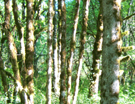Chapter 6: The Best Herbaceous Plants
From A Guide to Innovative Tree Farming in the Pacific Northwest by Mike Dubrasich. 2005. Whirlwind Press. For a hard copy of the book ($10 - includes shipping) please contact W.I.S.E. [here].
Best of the Best: Sword Fern (Polystichum munitum)
Runner-Up: Stinging Nettle (Urtica dioica ssp. gracilis)
Herbaceous plants are low-growing and non-woody, about as far from being trees as a plant can get. Most commercial herbaceous plants are more efficiently grown by row-cropping, or as nursery plants, not as tree farm crops. Nevertheless, innovative tree farmers also grow certain commercially valuable herbaceous plants that thrive in shade, and are easy to grow, harvest, and market.
Sword Fern
Sword ferns occur naturally in forests from Alaska to California and east to Montana, although they are more abundant in forests west of the Pacific Crest. Sword ferns survive in full sun (after clearcutting, for instance) but attain their best growth in shade.
Sword ferns have two markets: as live plants or as cut fronds for floral greenery. Nurseries, not tree farms, are the best places to grow live plants for commercial sale. Tree farms are good places to grow sword ferns for their fronds. Fresh-cut fronds are sold to domestic florists and international floral brokers. The market for Pacific Northwest sword fern fronds is truly world-wide.
One caveat tree farmers should be aware of is that the U.S. Forest Service currently encourages sword fern picking on public forests by commercial gatherers. This sad policy is harmful to the forests and harmful to the pickers. The tragic consequences are too numerous to detail here. One consequence, however, is that the ill-conceived Federal harvest depresses sword fern frond prices.
